Trying to move your team into agile marketing but worried that you need to retrain everyone? Or completely flatten your department’s structure? Or lay off half of your team?
Don’t panic! There’s no need for layoffs or completely changing your department’s structure. And while you may need to train your staff in the new process of work, there is no need to retrain everyone, as their current skills will still be needed in agile.
Agile marketing is adapted from agile software development so most of the team structure and roles are similar. The flat structures and the term ‘owner’ both come from the software side of things. But of course, a title like ‘marketing owner’ is a marketing-specific adaptation.
In this article, we'll be focusing on:
- How to structure an agile team
- Team roles within an agile team
- B2B examples
- The benefits of an agile marketing coach
How to structure an agile team
Ideally, the agile marketing team consists of 3-9 people - but before you worry, this doesn’t mean you can only have nine people in your marketing department. You may be running multiple projects at once, in which case you need multiple agile teams, one for every project (or section of a project).
You may have heard that agile marketing means a completely flat department structure - this is not the case. A flat-ish structure describes it best.
There should be at least one person ensuring the team(s) is meeting its objectives (so that’s two layers right there). In larger departments there might be three layers, we’ll get into job roles later in this article.
Cross-functional skills
You may be wondering whether a team of generalists or specialists is best. And while all B2B marketing departments are different, the answer may surprise you.
Having a mixture of both generalists and specialists on your team can give you an advantage in agile marketing. This is because some projects may require more of a certain task - when this happens your generalist can easily pick up the excess.
For example, if your project requires a lot of content creation, your generalist may be able to jump in with your content specialist to help with that, but if your next project requires more focus on email marketing, they could switch over. This gives you more flexibility than having only specialists, while still allowing for the benefits of expert knowledge.
Stable vs project teams
There are two types of agile marketing teams: stable and project. Stable teams stay consistent from project to project. They tend to be made up of in-house company employees, but if you have a stable relationship with an agency that team may also be considered stable.
A project team has a set start and end date as they only work together on a fixed objective or project and are then disbanded. Then new project teams are formed - this may allow more flexibility as you could customize teams based on each project.
You could choose to use either type of team or even both in your agile marketing strategy. It may take some time to work out which is best for your company but don’t worry - agile is all about testing!
Agile team roles
There are a few roles in agile marketing that differ from traditional marketing roles. These can help your team stay on track and keep up with the new agile way of working. However, you don’t need to incorporate all of them into your teams. This is another area where you should experiment with which roles benefit your team.
Agile team lead
This team member’s role is to help the team to meet its objectives. Essentially a team leader, they will help out with tasks as well as support staff with the more human aspects of agile marketing.
This role can be carried out by people also fulfilling other roles, for example your agile team's copywriter could also be your agile team lead. This will allow them to more effectively support the team with tasks. But this can be their sole job if it works better for your teams.
Marketing owner
The marketing owner is the communication link between marketing and other departments, such as sales and senior management. Ensuring the marketing team does what is needed while protecting the team from interruptions.
In smaller departments, the marketing director may take on this role, but ideally the marketing owner is devoted to this role.
Agile marketing director
Okay, so you might be thinking, “that’s just a marketing director with agile stuck on the front.” In which case, you’d be correct. But hear us out!
Adding ‘agile’ to the start of the top dog’s title helps to emphasize a departure from the old ways to the new leadership style associated with agile marketing. The agile marketing director has the same strategic position but instead of being a taskmaster, they take on more coaching and facilitator roles. Instead of simply evaluating the teams’ performance they share responsibility for the teams’ successes and failures.
This role is top of the chain and should be their only focus - you can’t be the agile marketing director and fulfil other roles.
B2B examples
Still not convinced over the practicalities of an agile team structure? Well, let's take a look at some B2B brands that are excelling with agile teams.
SEMRush
The marketing department at SEMRush is as close to fully flat as it can get - it’s all about empowering their teams. Leadership decides what needs to be done but not how to do it - the team decides that. This is similar to a coaching role. Due to agile marketing, SEMRush gained 500,000 users in 8 months!
Mozilla
Mozilla’s 100-person marketing team went agile and was split into groups of 5-7 people. Their teams had lots of generalists which allowed them to be organized into core KPIs.
This helps to clearly prioritize work - something that previously got lost in the large department.
The benefits of an agile marketing coach
Don’t feel like you have to try and set all this up yourself!
To help you in your quest for agility, a marketing coach may be a useful addition. Coaches can be internal or external to your organization. They can train you in all things agile from team dynamics to the agile mindset, with the goal of helping your department make the most of agile.
The agile marketing coach gives an objective view of your teams’ performance and can offer solutions to problems. Ultimately aiming for continual improvement of the work process - much like agile marketing itself.
Final thoughts
The most important thing about agile marketing team structure is that it has to work for your team. Agile marketing is known for its incremental changes and improvements - don’t be afraid to do the same in your team structures.
All teams are different so it's important to constantly change and adapt to what gets the best results. If that means working in project teams, an agile marketing coach, or monthly team-building - do what your team needs to get things done.
Got questions on setting up agile marketing teams? Wanna get advice and insights to share from your own experiences? Share them with our sister community, B2B Marketing Alliance.






.png)
.png)










 Follow us on LinkedIn
Follow us on LinkedIn



.svg?v=a55345d682)